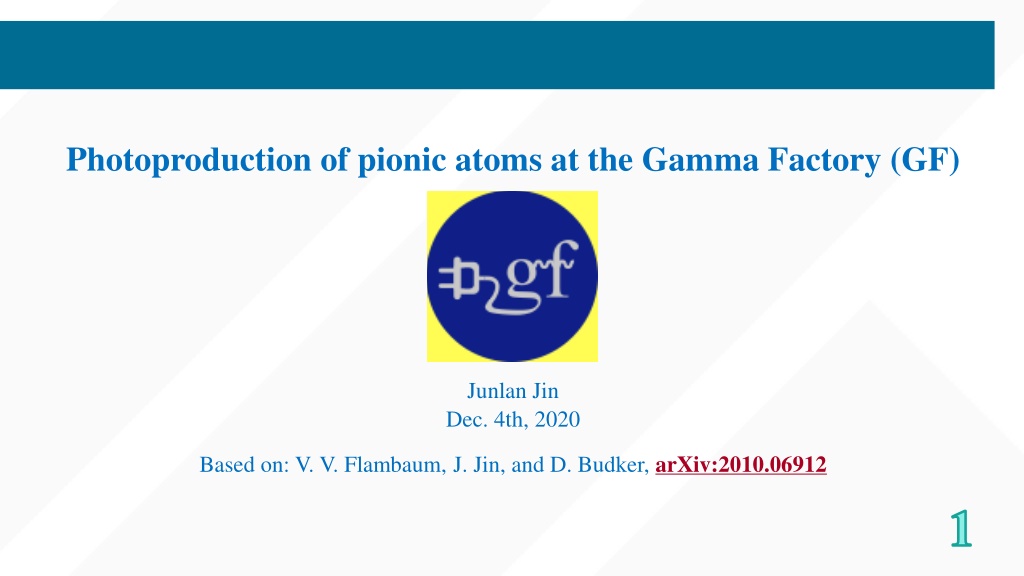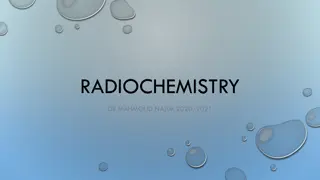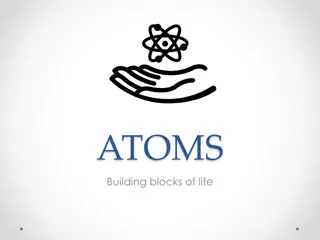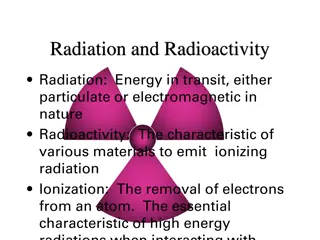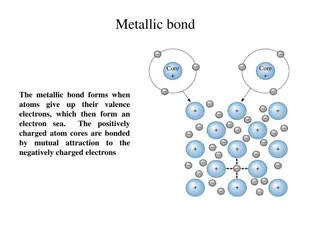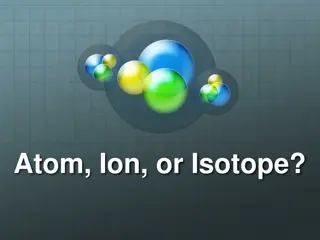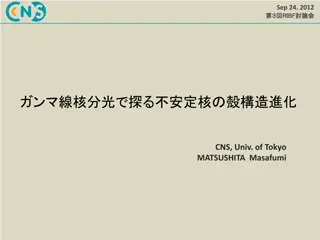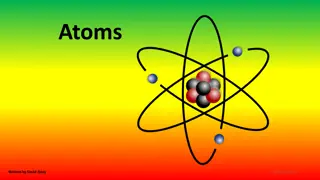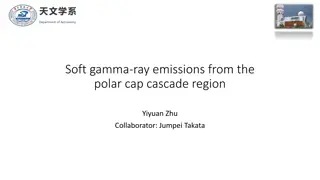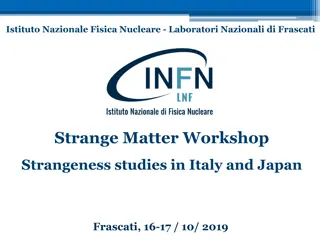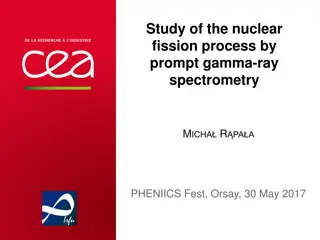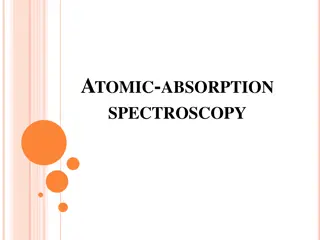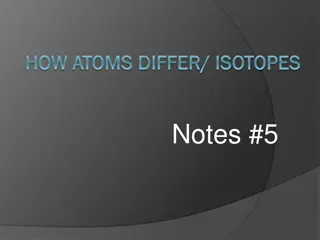Photoproduction of Pionic Atoms at the Gamma Factory: Research Overview
Research conducted by V. V. Flambaum, J. Jin, and D. Budker at the Gamma Factory (GF) on photoproduction of pionic atoms is detailed in this content. It explores the formation of pionic atoms with negative pions orbiting the nucleus in a hydrogen-like system, emphasizing strong interaction effects and pion-absorption broadening. The methods to produce pionic atoms and their absorption cross-section with monochromatic photons are discussed, highlighting the dominance of pion absorption. The study also delves into resonant absorption cross-sections and production rates at the GF, proposing novel ways to generate bound pions from the nucleus.
Download Presentation

Please find below an Image/Link to download the presentation.
The content on the website is provided AS IS for your information and personal use only. It may not be sold, licensed, or shared on other websites without obtaining consent from the author. Download presentation by click this link. If you encounter any issues during the download, it is possible that the publisher has removed the file from their server.
E N D
Presentation Transcript
Photoproduction of pionic atoms at the Gamma Factory (GF) Junlan Jin Dec. 4th, 2020 Based on: V. V. Flambaum, J. Jin, and D. Budker, arXiv:2010.06912 1
Outline 1. Pionic atoms 2. Pion absorption widths 3. Production rates at the GF 2
Pionic atoms a negative pion orbiting the nucleus e- hydrogen-like system m c2 140 MeV 270 me c2 - 3He, n=1 2fm 27000fm strong interaction effects 100fm pion-absorption broadening energy shift vs. Coulomb physics motivation GF photons with narrow band, tunable energy and high fluxes copious pions in bound states (not free pions) Produce pionic atoms in 1s state in heavy nuclei (deeply bound pionic states) strong interaction, nuclear structure and nuclear forces forming the structure J. H fner, Pions interact with nuclei, Physics Reports 21, 1 (1975) 3
Methods to produce pionic atoms coventional way stopping free pions in a - beam Production rate ~105 pionic atom /s X-ray cascade between circular states Deeply bound states cannot be produced Population of higher ns states is suppressed M. Hori, H. Aghai-Khozani, A. S t r, A. Dax, and D. Barna, Nature 581, 37 (2020) our proposal photoproduction of bound pions from the nucleus ( )ns + + ' A A 1 + + Z = Zi+1 , n p = + Z Z Z i i T. Ericson and W. Weise, Pions and Nuclei (Clarendon Press, 1988) 4 s-wave pion: larger probability to be produced inside the nucleus
Methods to produce pionic atoms absorption cross-section with monochromatic photons 2 + 2 1 I c E f = 27 2 2 ~ 10 cm 0 + + 2 1 I E + i tot = mc 2 2 140 E m c E MeV b k total width tot of ns pionic states: dominated by pion absorption ~ . 0 007 the ratio / tot : a rough estimate tot 5
Pion absorption width of ns states tot vs. photon energy-distribution width ph Width: pion absorption, X-ray radiation, Auger electron emission Pion absorption is usually dominant estimates 4 Z 2 ( , ) ) 0 ( Z n Z only valid for small Z tot 3 n fitting 1s width data ) 1 = ( , Z n tot 1 n ( , ) ( ) 1 , Z Z n tot tot 3 when Bohr orbital radius is larger than the nuclear radius E. Friedman and A. Gal, In-medium nuclear interactions of low-energy hadrons, Physics Reports 452, 89 (2007) J. Konijn, C. De Laat, A. Taal, and J. Koch, An improved parametrization of the optical potential for pionic atoms, Nuclear Physics A 519, 773 (1990) 6
Cross-sections resonant absorption 2 ( ) 2 / + = ( ) tot E 0 2 2 ( ) 2 / ( ) E E tot GF photons: nearly uniformly distributed up to the maximal energy To make full use of photons: ph > tot Proper collimation: suppress the background ( , ) Z n collimation ph = + j j ( , ) , 1 = tot Z n Z Z 17 10 j ph/sec eff 0 eff i i E ph pair production in nuclear field & Compton scattering 26 + 6 . 0 + 2 i 2 27 2 ( ) 10 ( ) ~ 10 Z Z Z cm cm 0 tot i pp scat i Particle Data Group, P. A. Zyla, et al., Review of particle physics, Progress of Theoretical and Experimental Physics 2020, 083C01 (2020) V. B. Berestetskii, L. P. Pitaevskii, and E. M. Lifshitz, Quantum Electrodynamics (Pergamon Press Ltd, 1982) 7
Production rates at GF production rates ( , ) Z n p = jeff eff(Zi, n)/ tot(Zi) ph = + ( , ) , 1 tot j j Z n Z Z 0 eff i i eff E ) ph 26 + 6 . 0 + 2 i 2 ( 10 ( ) Z Z Z cm tot i pp scat i 1s pionic atoms: up to ~1010sec-1(~105in the conventional way) deeply bound 1s state and higher ns states production of nl (l > 0) states choice of ph ph = tot (Z, n) ph = 1s binding energy to produce different ns states simultaneouly 8
Photoproduction of kaonic atoms kaonic atoms 28 2 10 cm 0 E mK c2 500 MeV > 400 MeV, need primary photons with higher energy 26 2 i 2 ( ) 9 . 0 10 Z Z cm tot i pp production rates of low ns staets fitting 1s width data E. Friedman and A. Gal, Nuclear Physics A 658, 345 (1999) E. Friedman and A. Gal, Physics Letters B 459, 43 (1999) C. Curceanu, C. Guaraldo, M. Iliescu, M. Cargnelli, R. Hayano, J. Marton, J. Zmeskal, T. Ishiwatari, M. Iwasaki, S. Okada, D. L. Sirghi, and H. Tatsuno, Rev. Mod. Phys. 91, 025006 (2019) 9 1s kaonic atoms: up to ~109 sec-1
Summary Resonance photoproduction pionic atoms production rates up to ~1010/s deeply bound pionic states higher ns states and nl (l > 0) states kaonic atoms production rates up to ~109/s 10
